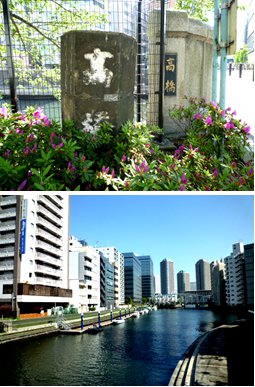There is an old main pillar next to Takahashi over the Kamejima River. "Takahashi" is an old bridge that is also described in the early Edo period pictorial drawings, and is said to have passed when Akaho Nanji was repatriated. Recently, mooring and storage facilities for small ships have been established nearby, and the waterside has been improved. I would like to take a look at the history of Takahashi.
 The current "Takahashi" opened in March 1984 (1984) and spans the Kajibashi Street connecting Hatchobori and Shinkawa on the Kamejima River. The downstream from here flows through Minami Takahashi to the Sumida River. The remaining main pillar is located at Takahashi Southeast Children's Amusement Park on the Shinkawa side. This seems to be from a concrete arch bridge that was replaced in 1919 (1919). (Upper photo: The left is the old bridge, and the right is the main pillar of the current bridge.)
The current "Takahashi" opened in March 1984 (1984) and spans the Kajibashi Street connecting Hatchobori and Shinkawa on the Kamejima River. The downstream from here flows through Minami Takahashi to the Sumida River. The remaining main pillar is located at Takahashi Southeast Children's Amusement Park on the Shinkawa side. This seems to be from a concrete arch bridge that was replaced in 1919 (1919). (Upper photo: The left is the old bridge, and the right is the main pillar of the current bridge.)
"It is described as a name bridge in the Masayasu Edo Map, which is considered to be a figure from 1644 (1644) to July of the following year (1645). In addition, the origin of the name is said to be derived from the frequent entry and exit of ships because it was built near the mouth of the Kamejima River, and a bridge with a high pier was built." ("Chuo-ku Bridge / Hashizume Square" Chuo-ku Modern Bridge Survey (Chuo-ku Board of Education, 1998)).
During the Edo period, Takahashi was the bridge at the lowermost stream of the Kamejima River, and from Edo Minato to Inari Bridge was at Funairi to Hatchobori (Horiwari), where large ships could only enter this far. The scenery is depicted in "Hundred Views of Edo" and "Tetsubosu Inaribashi Minato Shrine" (Hiroshige). The Shinkawa side was on the banks of the Shogen River.
In addition, "The iron foil truss bridge completed in October 1882 (1882) was the first domestic bridge designed by Japanese engineer Haraguchi Kaname" (same book), and this landscape is Yasuji Inoue's painting "The view of Rei Kishijima Takahashi" depicts a black-painted truss bridge.
Currently, the Kamejima River mooring storage facility managed by the Tokyo Metropolitan Park Association has been set up in the water area between Takahashi and Minami Takahashi so that about 10 ships can be moored (lower photo: Shinkawa side on the left bank seen from Takahashi, and the right bank is Hatchobori Funairi). @ Akira Makibuchi

